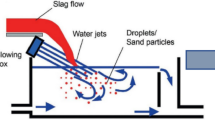Abstract
Nowadays, the technology that has been into the industry revolves around the use of sensors and motors to segregate the waste that is put into the machine/bins. Machine automatically senses the type of waste being put into it and it segregates and pushes down the waste into the respective bin, but these machines have been built on an industrial scale which uses massive conveyer belts and more advanced technology to sense the type of the waste, and these machines are quick but very expensive. The automation in these machines is of utmost importance, and different controls are required for temperature management, operation, and other specific variable control. The present work is the effort of making a scalable model of stone and gas segregator machine. The objective is to segregate glass with similar materials having similar properties. In this study, a framework is proposed for designing and controlling the various sensors that will be used in machine.
Access this chapter
Tax calculation will be finalised at checkout
Purchases are for personal use only
Similar content being viewed by others
References
Lou Z, Bilitewski B, Zhu N, Chai X, Li B, Zhao Y (2015) Environmental impacts of a large-scale incinerator with mixed MSW of highwater content from a LCA perspective. J Environ Sci 30:173–179. https://doi.org/10.1016/j.jes.2014.10.004
Priti, Mandal K (2019) Review on evolution of municipal solid waste management in India: practices, challenges and policy implications. J Mater Cycles Waste Manag 21(6):1263–1279. https://doi.org/10.1007/s10163-019-00880-y
Gundupalli SP, Hait S, Thakur A (2017) Multi-material classification of dry recyclables from municipal solid waste based on thermal imaging. Waste Manage 70:13–21. https://doi.org/10.1016/j.wasman.2017.09.019
Subramanian PM (2000) Plastics recycling and waste management in the US. Resour Conserv Recycl 28(3–4):253–263. https://doi.org/10.1016/S0921-3449(99)00049-X
Srivastava P, Sindhwani R, Sharma BP, Singla AV, Gupta R, Goyal A (2021) Development of automatic waste identification and segregation system. Mater Today Proc 47:3943–3946. https://doi.org/10.1016/j.matpr.2021.03.648
Thanawala D, Sarin A, Verma P (2020) An approach to waste segregation and management using convolutional neural networks, pp 139–150. https://doi.org/10.1007/978-981-15-6634-9_14
Ramachandran V, Gilbert SR (1995) Recovering metals from wastes. JOM 47(2):64–64. https://doi.org/10.1007/BF03221412
Zhang G et al (2017) New technology for recovering residual metals from nonmetallic fractions of waste printed circuit boards. Waste Manage 64:228–235. https://doi.org/10.1016/j.wasman.2017.03.030
Vasilyev AM, Kuskov VB (2017) Regularities of fine-grained materials separation process on concentrating table. Obogashchenie Rud, pp 63–68. https://doi.org/10.17580/or.2017.03.10
Moher DA, David, Liberati A, Tetzlaff J, Altman DG, Altman D, Antes G (2009) Preferred reporting items for systematic reviews and meta-analyses: the PRISMA statement. J Chinese Integ Med 7(9):889–896
Author information
Authors and Affiliations
Corresponding authors
Editor information
Editors and Affiliations
Rights and permissions
Copyright information
© 2023 The Author(s), under exclusive license to Springer Nature Singapore Pte Ltd.
About this paper
Cite this paper
Srivastava, P. et al. (2023). Framework for Design and Control of Automatic Stone—Glass Separator. In: Sharma, R., Kannojiya, R., Garg, N., Gautam, S.S. (eds) Advances in Engineering Design. FLAME 2022. Lecture Notes in Mechanical Engineering. Springer, Singapore. https://doi.org/10.1007/978-981-99-3033-3_6
Download citation
DOI: https://doi.org/10.1007/978-981-99-3033-3_6
Published:
Publisher Name: Springer, Singapore
Print ISBN: 978-981-99-3032-6
Online ISBN: 978-981-99-3033-3
eBook Packages: EngineeringEngineering (R0)




